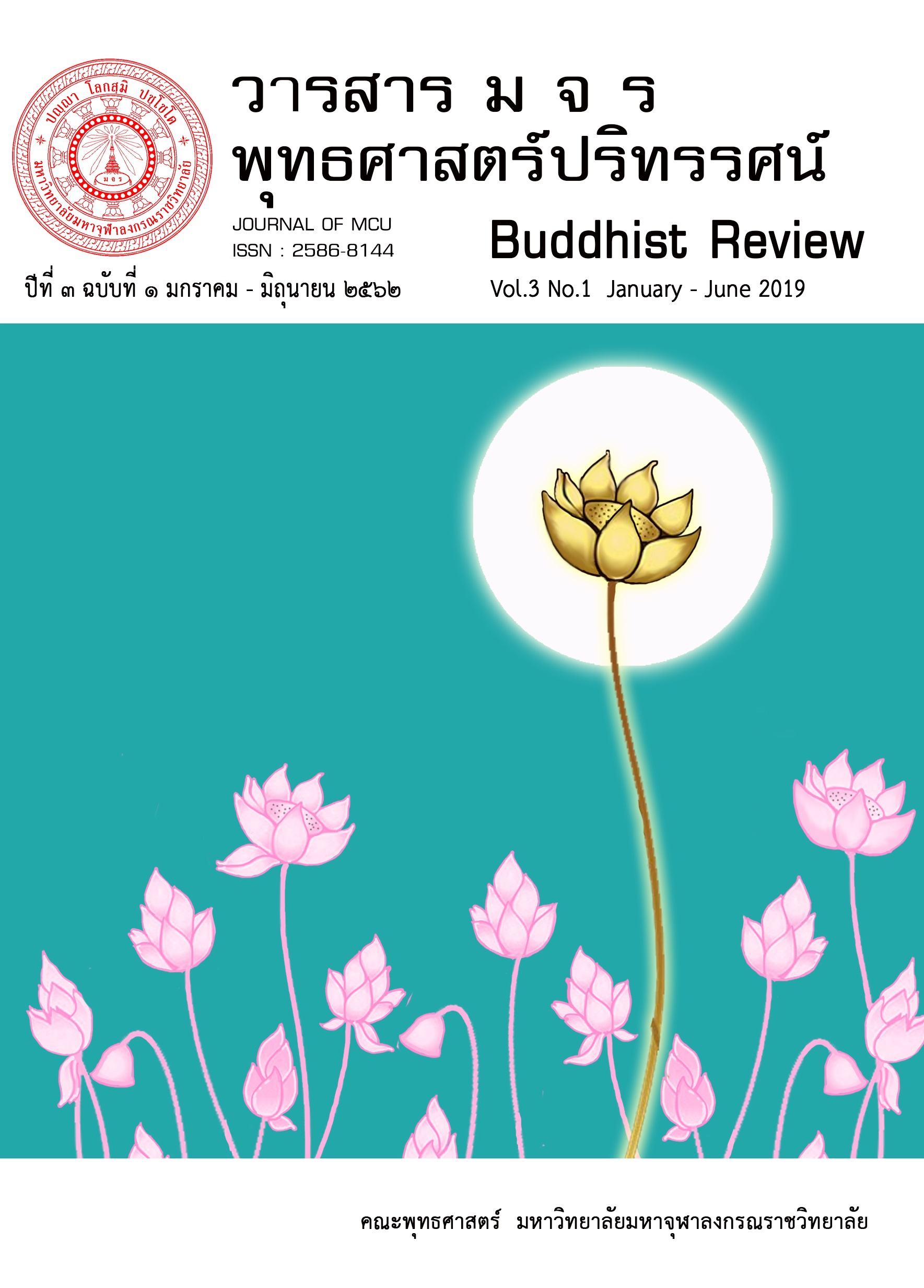การพัฒนาวัดให้เป็นศูนย์กลางการวิปัสสนากัมมัฏฐาน
Main Article Content
บทคัดย่อ
บทความวิจัยนี้ มีวัตถุประสงค์ ๒ ประการ คือ ๑) เพื่อศึกษารูปแบบการปฏิบัติวิปัสสนากัมมัฏฐานของวัดในจังหวัดฉะเชิงเทรา ๒) เพื่อวิเคราะห์ให้เห็นปัจจัยพัฒนาวัดให้เป็นศูนย์กลางในการปฏิบัติวิปัสสนากัมมัฏฐาน โดยการนาหลักธรรมที่ปรากฏในคัมภีร์พระไตรปิฎก อรรถกถา ฎีกา วิสุทธิมรรค การตีความขยายความของนักวิชาการทางพระพุทธศาสนา และศึกษารูปแบบการสอนวิปัสสนากัมมัฏฐาน ของสถานที่ ที่เป็นกลุ่มตัวอย่าง เพื่อพัฒนาวัดให้เป็นศูนย์กลางการวิปัสสนากัมมัฏฐาน
ผลการศึกษาพบว่า รูปแบบการปฏิบัติวิปัสสนากัมมัฏฐานในจังหวัดฉะเชิงเทรา ไม่แพร่หลายมากนักตามวัด แต่ปรากฏว่าการปฏิบัติวิปัสสนากัมมัฏฐานตามสำนักปฏิบัติธรรมประจาจังหวัด และสำนักปฏิบัติของสำนักต่าง ๆ ที่มีผู้ศรัทธาในการปฏิบัติตามหลักคำสอนขององค์สมเด็จพระสัมมาสัมพุทธเจ้า ด้วยเหตุนั้น รูปแบบในการปฏิบัติจึงไม่มีความเป็นหนึ่งเดียวหากแต่เป็นไปตามหลักการสอนของแต่ละสานัก ส่วนวัดตัวอย่าง ได้แก่ วัดสุวรรณมาตร วัดบ้านซ่อง และวัดปากน้าบางคล้า ทั้ง ๓ วัด มีความต้องการในการพัฒนาวัดให้เป็นศูนย์กลางการปฏิบัติวิปัสสนากัมมัฏฐาน และปัจจัยที่เอื้อให้เกิดความเป็นศูนย์กลางในการปฏิบัติ คือ ๑) ด้านการพัฒนารูปแบบของการปฏิบัติ ๒) ด้านการพัฒนาศักยภาพของพระในวัดให้เป็นพระวิปัสสนาจารย์ ๓) ด้านความต้องการของผู้มาปฏิบัติทั่วไปที่มาปฏิบัติในวัด ๔) ด้านความต้องการของชุมชนและหน่วยงานที่มีส่วนเกี่ยวข้อง และ ๕) ด้านความต้องการของชุมชนในการมีส่วนร่วม
Article Details
- บทความที่ได้รับการตีพิมพ์เป็นลิขสิทธิ์ของวารสาร มจร พุทธศาสตร์ปริทรรศน์
- ข้อความใดๆ ที่ปรากฎในบทความที่ได้รับการตีพิมพ์ในวารสาร ถือเป็นความรับผิดชอบของผู้เขียนบทความ และข้อคิดเห็นนั้นไม่ถือว่าเป็นทัศนะและความรับผิดชอบของกองบรรณาธิการวารสาร มจร พุทธศาสตร์ปริทรรศน์
เอกสารอ้างอิง
ธนิต อยู่โพธิ์. วิปัสสนานิยม. กรุงเทพมหานคร: โรงพิมพ์มหาจุฬาลงกรณราชวิทยาลัย, ๒๕๔๐.
ภัทรนิทธิ์ วิสุทธิศักดิ์. “รูปแบบการผสมผสานการปฏิบัติวิปัสสนากรรมฐานตามหลักสติปัฏฐาน”.วิทยานิพนธ์พุทธศาสตรดุษฎีบัณฑิต. บัณฑิตวิทยาลัย: มหาวิทยาลัยมหาจุฬาลงกรณ์ราชวิทยาลัย, ๒๕๕๐.
พระครูภาวนาวิริยานุโยค (บุญยงค์ ถาวโร). “กระบวนการบริหารจัดการโครงการอบรมวิปัสสนากัมมัฏฐานของ สานักปฏิบัติธรรมประจาจังหวัดในประเทศไทย”. วิทยานิพนธ์พุทธศาสตรดุษฎีบัณฑิต. บัณฑิตวิทยาลัย: มหาวิทยาลัยมหาจุฬาลงกรณราชวิทยาลัย, ๒๕๖๐.
พระปัญญาวโรภิกฺขุ. หลักการปฏิบัติวิปัสสนาภาวนาเบื้องต้น. กรุงเทพมหานคร: โรงพิมพ์มหาจุฬาลงกรณราชวิทยาลัย, ๒๕๕๔.
พระโสภณมหาเถระ (มหาสีสยาดอ). มหาสติปัฏฐานสูตร. กรุงเทพมหานคร: ห้างหุ้นส่วนจากัด ประยูรสาส์นไทย การพิมพ์, ๒๕๕๕.
พระโสภณมหาเถระ (มหาสีสยาดอ) ธัมมจักกัปปวัตนสูตร.กรุงเทพมหานคร: ห้างหุ้นส่วนจากัด ประยูรสาน์สไทยการพิมพ์, ๒๕๕๕.
พระโสภณมหาเถระ (มหาสีสยาดอ) นิพพานกถา. กรุงเทพมหานคร: ห้างหุ้นส่วนจากัด ประยูรสาส์นไทยการพิมพ์, ๒๕๕๔.
พระโสภณมหาเถระ (มหาสีสยาดอ) วิปัสสนานัย เล่ม ๑. กรุงเทพมหานคร: ห้างหุ้นส่วนจากัด ประยูรสาส์นไทยการพิมพ์, ๒๕๕๕.
พระโสภณมหาเถระ (มหาสีสยาดอ) วิปัสสนานัย เล่ม ๒. กรุงเทพมหานคร: ห้างหุ้นส่วนจากัด ประยูรสาส์นไทยการพิมพ์, ๒๕๕๕.
มหาจุฬาลงกรณราชวิทยาลัย. พระไตรปิฎกภาษาไทย. ฉบับมหาจุฬาลงกรณราชวิทยาลัย. กรุงเทพมหานคร: โรงพิมพ์มหาจุฬาลงกรณ์ราชวิทยาลัย, ๒๕๓๙.
วัดหลวงพ่อสดธรรมกายาราม. คู่มือปฏิบัติสมถวิปัสสนากรรมฐาน ๕ สาย. นครปฐม: เพชรเกษม พริ้นติ้ง กรุ๊ป, ๒๕๕๓.
AnalayoBhikkhu. Satipatthana: The Direct Path to Realization. Selangor: Buddhist Wisdom Centre, 2006.


